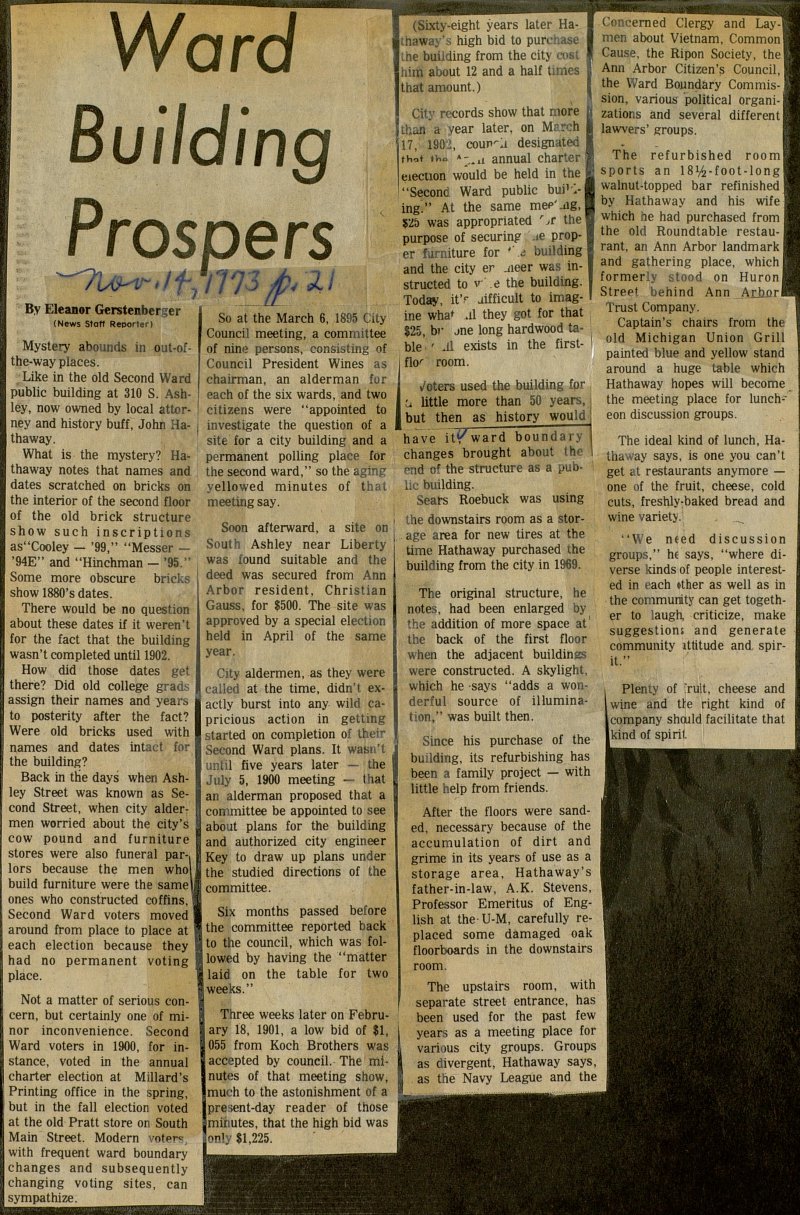Ward Building Prospers


Mystery abounds in out-ofthe-way places. Like in the old Second Ward public building at 310 S. Ashley, now owned by local attorney and history buff, John Hathaway. What is the mystery? Hathaway notes that ñames and dates scratched on bricks on the interior of the second floor of the old brick structure show such inscriptions as"Cooley - '99," "Messer - '94E" and "Hinchman - '95." Some more obscure bricks show 1880's dates. There would be no question about these dates if it weren 't for the fact that the building wasn't completed until 1902. How did those dates get there? Did old college gra assign their names and years to posterity after the fact? Were old bricks used with names and dates intact the building? Back in the days when Ashley Street was known as Second Street, when city aldermen worried about the city's cow pound and furniture stores were also funeral par-, lors because the men whol build furniture were the samei ones who constructed coffins, Second Ward voters moved around from place to place at each election because they ' had no permanent voting place. Not a matter of serious concern, but certainly one of minor inconveniehce. Second Ward voters in 1900, for instance, voted in the annual charter election at Millard's Printing office in the spring, but in the fall election voted at the old Pratt store on South Main Street. Modern vote with frequent ward boundary changes and subsequently changing voting sites, can sympathize. So at the March 6, 1895 City Council meeting, a committee of nine persons, consisting of Council President Wines as chairman, an alderman for each of the six wards, and two citizens were "appointed to investígate the question of a site for a city building and a permanent polling place for the second ward," so the aging yellowed minutes of that meeting say. Soon afterward, a site on South Ashley near Liberty was found suitable and deed was secured from Ann Arbor resident, Christian Gauss, for $500. The site was approved by a special election held in April of the same year. City aldermen, as they were d at the time, didn't exactly burst into any wild capricious action in getting started on completion of their Second Ward plans. It wasi until five years later - the July 5, 1900 meeting - Ihat an alderman proposed that a committee be appointed to see about plans for the building and authorized city engineer Key to draw up plans under the studied directions of the committee. Six months passed before the committee reported back to the council, which was followed by having the "matter laid on the table for two I weeks." Three weeks later on February 18, 1901, a low bid of $1, 055 from Koch Brothers was accepted by council. The mijnutes of that meeting show, jmuch to the astonishment of a jpresent-day reader of those jmiiiutes, that the high bid was only $1,225. (Sixty-eight years later Hathaway's high bid to purehase the building from the city cost him about 12 and a half times that amount.) City records show that more than a year later, on M 17, 1902, coup'" li designated thot tho -wl annual charter eiection would be held in the "Second Ward public buiging." At the same mep'-iig, ?2& was appropriated ',r the purpose of securing .ie proper furniture for '' t building and the city er jieer was instructed to v'.e the building. Today, it'r aifficult to imagine wha' .il they got for that $25, bv jne long hardwood table ' .11 exists in the firstflo room. koters used the building fpr ■a little more than 50 years, but then as history would have itward boundary changes brought about t end of the structure as a public building. Sears Roebuck was using the downstairs room as a storage área for new tires at the time Hathaway purchased the building from the city in 1969. The original structure, he notes, had been enlarged by the addition of more space at' : back of the first floor when the adjacent buildings were constructed. A skylight, which he says "adds a wonderful source of illumination," was built then. Since his purchase of the building, its refurbishing has been a family project - with little help from friends. After the floors were sanded, necessary because of the accumulation of dirt and grime in its years of use as a storage area, Hathaway's father-in-law, A.K. Stevens, Professor Emeritus of English at U-M, carefully replaced some damaged oak floorboards in the downstairs room. The upstairs room, with separate street entrance, has been used for the past few years as a meeting place for various city groups. Groups as divergent, Hathaway says, as the Navy League and the Concerned Clergy and Lay-! men about Vietnam, Common Cause, the Ripon Society, the Ann Arbor Citizen's Council, the Ward Boundary Commission, various political organizations and several different lawvers' groups. The refurbished room sports an 18%-foot-long walnut-topped bar refinished by Hathaway and his wife which he had purchased from the old Roundtable restaurant, an Ann Arbor landmark and gathering place, which formerly i ;ood on Huroni Streef behind Ann Arbj)rl Trust Company. Captain's chairs from the oíd Michigan Union Grill painted blue and yellow stand around a huge table which Hathaway hopes will become the meeting place for lunch-" eon discussion groups. The ideal kind of lunch, Hathaway says, is one you can't get at restaurants anymore - one of the fruit, cheese, cold cuts, freshly-baked bread and wine variety. "We need discussion groups," he says, "where diverse kinds of people interested in each other as well as in the commuráty can get together to laugh, criticize, make suggestions and genérate community ittitude and spirit." I Plenty of 'ruit, cheese and wine and tre right kind of [company should facilítate that Ikind of spirit